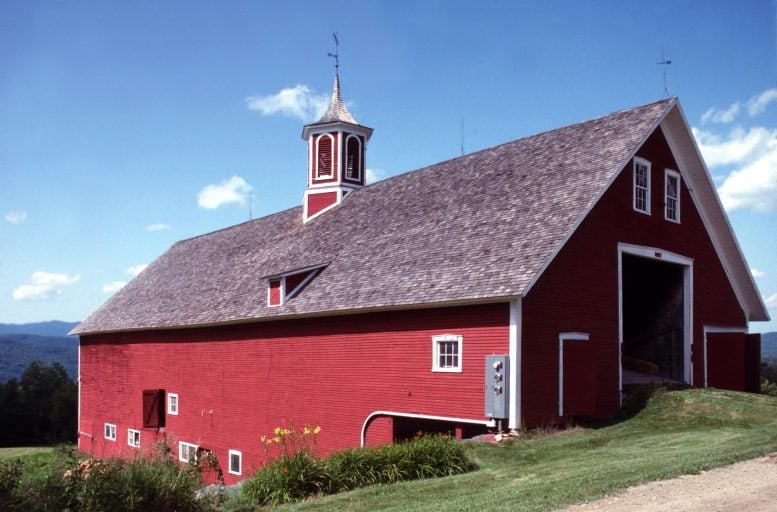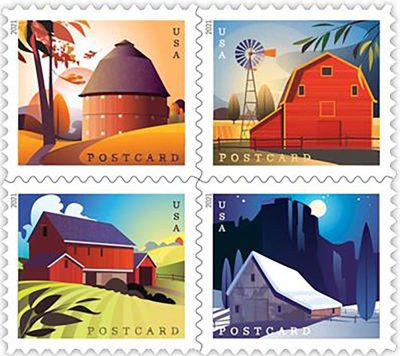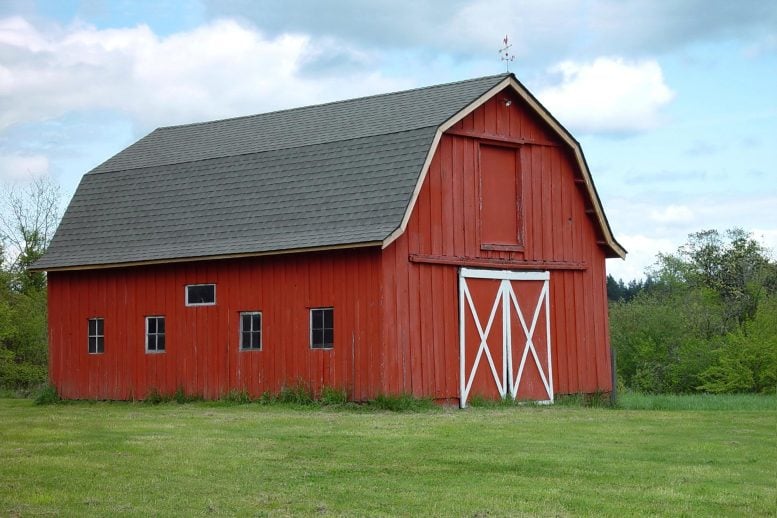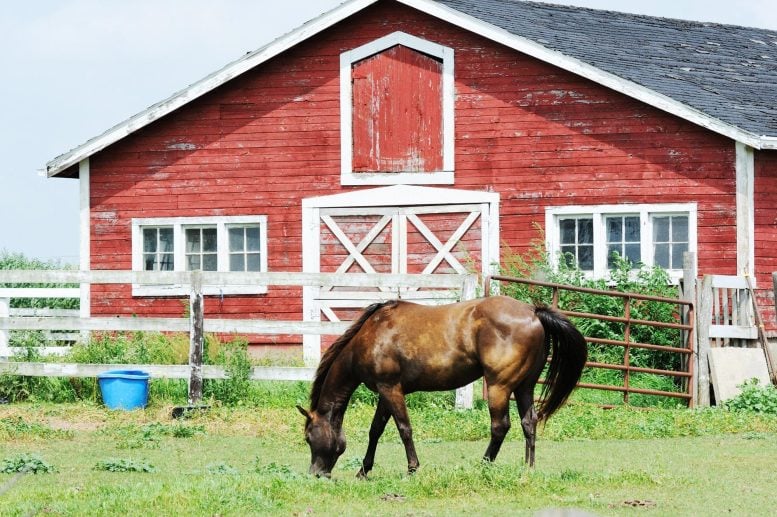There are three reasons we see so many red American barns. It’s traditional, it’s practical and the color looks good.
Although the main reason to paint wooden buildings is for appearances, paint also protects the wood so it lasts longer.
During the 1700s and early 1800s, barns on family farms in the Northeast U.S. were typically covered with thick vertical boards. When they were left unpainted, the boards would slowly weather to a brownish-gray color.
But after the mid-1800s, to improve the efficiency of their barns by reducing drafts to help keep their animals more comfortable in winter, many farmers tightened up their barns by having wooden clapboards horizontally nailed on the outside barn walls. These clapboards were sawed quite thin, so painting them provided needed protection and dressed up the appearance of the barns.

A dairy barn in Waitsfield, Vermont, built circa 1890. Credit: Thomas Visser, CC BY-ND
In the 1800s it was common for people to make their own paints by mixing pigments with linseed oil made from flax seeds and other ingredients. Pigments are dry materials that add color. They were available in various hues, but the tint we see so often on older American barns was called Venetian red.
According to the 1884 edition of “Everybody’s Paint Book,” by F.B. Gardner, Venetian red was “suitable for any common work, or for brickwork and outbuildings.” This red pigment penetrated well into wooden barn boards and resisted fading when exposed to sunlight, so it could age gracefully for generations.
Venetian red got its name because historically this pigment was produced from natural clays found near Venice, Italy. The clays contained an iron oxide compound that produced this red color.
But as people found similar iron oxide deposits in many other places, “Venetian red” became a generic term for light red pigments that did not have any purplish tinge. By the 1920s, such “earth pigments” used to make red paints were being dug in Georgia, Pennsylvania, Virginia, Alabama, California, Iowa, and Vermont.

These stamps, released January 24, 2021, show a round barn surrounded by the hazy light and warm colors of fall; a gambrel-roofed barn in summer; a forebay barn in an early spring countryside; and a Western barn on a winter’s night. USPS, artwork by Kim Johnson, CC BY-ND
By the late 1800s, in addition to red, it became fashionable to paint barns with other color schemes, especially those designed to complement the architectural styles and finishes of the owners’ houses. These included various hues of yellows, greens, and browns. Also, white paint commonly was applied to barns and houses.
But red paint remained popular on many farms because it was the most affordable. In 1922 the Sears, Roebuck catalogue offered red barn paint for just $1.43 per gallon, while other colors of house paints sold for at least $2.25 per gallon – nearly twice as much.
Today, many modern barns don’t resemble classic versions. Very large barns that hold hundreds of cows or pigs look more like hangars or warehouses, and may be built of metal. But the tradition of painting smaller barns red continues – so strongly that the U.S. Postal Service now celebrates them on postage stamps.
Written by Thomas Durant Visser, Professor of Historic Preservation, University of Vermont.
This article was first published in The Conversation.![]()











Hmmm. When I was a kid in the midwest in the 40s, the paint of choice for barns was ‘red lead’. It was antifungal and prevented rot.
I had heard the same as you, K.C., but in the 1950s.
Sounds more believable to me. Farmers are practical not fashionable.
In my area in the 60s most dairy barns were white, most beef barns red
Cool
I have seen very few red barns where I live. I grew up on a horse farm and our barn was built using creosote pilings and 1-1/2″ thick treated wood on the outside and never painted.Inside the stalls were built with 2×4’s and 1″ thick plywood.Some horses have issues with eating wood so it’s not a good idea to paint or used treated wood as it could poison them. We never painted it and neither did anyone else around here.It could be because South Louisiana doesn’t get alot of cold weather.I’m 51 and our barn was built long before I was born and it’s still beautiful and very low maintenance.
I had thought that originally barns were painted with a mixture of blood from slaughtered livestock and excess milk.
Enjoyed reading this little piece of history. Thank you. I’ve seen the famous picturesque Jenne Farm in Reading, Vermont. Peaceful,simple beauty.
Being born & raised in Vermont the majority of the barns are red w/white trim. While picking a color for his garage and shed. I started painting both of them barn red/white. The paint was $10/gal the others $20/gal its still there 15yrs later& a little faded. I had so many compliments 15 yes ago the majority of residents from Vermont city Bennington
Except in parts of Kentucky where function requires slightly different vernacular architecture construction methods and where barns are often painted black.
Because a red barn is the heart of the farm
In Kentucky barns are usually always painted black. It attracts more heat to cure hanging tobacco.
I’ve always heard that one or more (tobacco?) Companies would paint your barn free, if they could paint their sign (in their colors) on your barn. Red being the background color. Many photos of this exist.
https://home.howstuffworks.com/question635.htm#:~:text=Red%20barns%20are%20common%20sights%20throughout%20rural%20America.&text=They%20would%20paint%20their%20barns,that%20dried%20and%20hardened%20quickly.&text=Wealthy%20farmers%20added%20blood%20from%20a%20recent%20slaughter%20to%20the%20oil%20mixture.
The true reason is that the red barns were easier for the bank president could more easily spot the farms that the bank had forclosed on as he was driven around the county. Most farmers painted their Barns the same color as their homes.
Red is easier to see in winter amd all year when miles away on large properties
Can you please take the time to teach everyone in your industry to write. The fact that I got the answer in the first sentence and then more details as we progressed made this a delight to read and I would like you to fire everyone else in the industry and take over their positions.
Valid point. I only take issue with the author calling $2.25 “nearly twice as much” as $1.43! Maybe it’s just me, but 57% more isn’t quite enough in my mind to be considered nearly 100% more. Even on a logarithmic scale, it’s not even 2/3 of the way from unity to double, but I could be nitpicking 🙂
The red paint was made from iron oxide which made it cheaper to manufacture and it protected the wood from rot caused by dampness.
Lots of barns in Iowa and Missouri have a quilt pattern painted on them. I love this idea and look for them when I travel. I have fond memories of the old barn on our farm.
I’m not from the US, but live here now.. I genuinely figured that it was because most farmers were Republicans 😂..
Considering a lot of red sheds also came with trump flags and other racist slogans.
It is true barns are red because the paint is cheaper. Why is red paint cheaper? Because they sell so much. And that’s that!
Also in the 40s the red paint used on ships contained lead to kill barnacles and was called red lead.
My uncle, a farmer, told me this story: Most often, farmers carried a loan on their land. The barns were red while you were paying off the loan ( in the red). Once you owned your land, you painted your barn white to show you were in the clear.
My father used to say that if a Presbyterian church had painted their front doors red, it meant they had paid off their mortgage.
Enjoyed the article, interesting and well written. One issue though, you indicated early in the article, the purpose for painting wood was aesthetic with a byproduct of protecting it. In fact, the purpose of painting wood is to protect it; the purpose of using colors is aesthetics, though some colors provide additional protection. Really well written article though.
Interesting
I also thought the Red was for winter. So during snow you can see your way home. And also it’s pretty. Nothing like a Red Barn in a Winter Snow…im an artist so I like the beauty of it all. Great story…
I was told more red barns in north to help absorb sun warmth in winter. In south more were white to reflect heat of summer
The red was surplus blood post slaughter. Similar to oil paint. Dairy farms are white.
I always thought it was to keep flying insects especially bees and wasps from making nests for they are deterred by the color red
Red was the cheapest paint available. Same reason school houses were red.
Early attempts at making wood fire proof was a mixture of chemicals that produced a deep red tint paint. So red barns where an attempt to make them fire resistant. A museum I know found a recipe for such paint in the papers of an early 19th century farmer and the result was Pizza hut red.
Most likely it was a tradition brought from Northern Europe where it was used since the 1600s. The iron oxide makes it mold resistant.
https://en.wikipedia.org/wiki/Falu_red
That’s a different reason from what I heard. The reason I heard was that country folks went to town and were impressed by the fire engines which were painted red, so they went home and painted their barns red, But that doesn’t explain why fire trucks were painted red. Fire trucks were painted red because each truck had four wheels and eight men which makes twelve. Well their are twelve inches in a ruler and great ruler was Queen Elizabeth but Queen Elizabeth was also an ocean liner that sailed the high seas. Since the sea was full of fish and the fish have fins, and the Finns were always fighting the Russians or the Reds, and the fire trucks were always rushin’ around town, they painted them red.
I find it curious so many adults believe you’d use blood to paint a building already vulnerable to flies. Blood stinks. Tillamook OR barn quilts are a fine example of the Chamber of Commerce driven practice of art on barns, but not the origin of it.
The reason barns are red is because they made a oil on other animals and put the blood of their animals in the oil and it made it red no that’s not politically correct but truth is never politically correct
I live in kansas most farms have 2 barns one for hay which are usually white to reflect heat and keep the straw from molding the cow barns are usually red to absorb heat in winter trust me a farmer never spent any money to make anything look pretty or to advertise his position with the bank. and the thought of so he could find his way home is well stupid he knows where home is and dosent care if you find it or not
A building supply salesman in Kansas told me farmers bought red paint because it was the cheapest. I asked him why would it be the cheapest. He said the manufacturers could make it cheaper because so many farmers bought it to paint their barns.
It’s strange that barn paint red is cheaper, while automotive paint red is more expensive.
Brian, we prefer the merit system but welcome anyways lol.
Thanks interesting read,SW use aluminum oxide to put in their left overs and other unsold paints in large batch so they could sell it cheep. That process ended when ingredient labels and material safety data sheets were required
White barns were government funded. Most dairy ( government cheese). And the crime rate is higher where white barns are.. leaded paint. Leaded paint was 98% lead. Very heavy.
The barns were the boat builder that lost your jobs, cause of steel. Germans
Most barns in Massachusetts are red outside,unpainted inside,in case animals decide to chew while housed inside.
I grew up on a farm. All of the barns in our “neighborhood” were white. We had an old bar that we tore down that was red but I can’t think of any that our farm family friends had that were red. All of them were white, still are actually
I grew up on a farm. All of the barns in our “neighborhood” were white. We had an old barn that we tore down that was red but I can’t think of any that our farm family friends had that were red. All of them were white, still are actually
Brian,
Wow so glad you brought politics into something that didn’t need it, but since you decided to show your ignorance I will help you out. Not that long ago the colors typically showed on maps for the political parties changed. Democrats we’re the color red because they were closely tired to communist socialist clauses and policies. Wanting to distance their connection to these they got the media, who is in their back pocket and obediently does as told for the Democrats, changed the color scheme.
I grew up in Wisconsin. Almost all I that I remember seeing were red.
I was taught in school and going on many field trips to farms, and was told about the availability of red berries for stain and paint, but the other lifesaving practical use of red was to be able to find the barn during blizzards.Red barns stayed red for this reason.
Alot of good information on this blog, thanks!